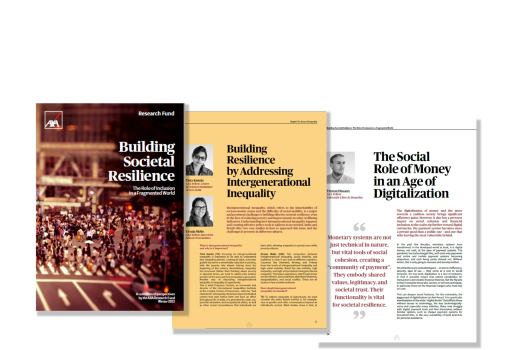Intergenerational inequality, which refers to the inheritability of socioeconomic status and the difficulty of social mobility, is a major and persistent challenge to building effective societal resilience, even in the face of reducing poverty and improvements in other wellbeing indicators. Understanding how intergenerational inequality happens and creating effective policy tools to address it are needed. India and Brazil offer two case studies in how to approach this issue and the challenges it presents in different cultures.
What is intergenerational inequality and why is it important?
Tista Kundu (TK): Focusing on intergenerational inequality is important to be able to understand why inequality persists. Looking at India, economic growth has led to a remarkable reduction in poverty, with the poverty rate almost halving since the beginning of this century. Nevertheless, inequality has increased. Rather than thinking about poverty in absolute terms, we need to address the relative position of the poor and how inequality is generated. Another way of describing intergenerational inequality is inequality of opportunity.
This is what Francisco Ferreira, an economist and director of the International Inequalities Institute at the London School of Economics, calls the “bad cholesterol” of inequality, the factors beyond individual control that start before birth and have an effect throughout life. In India, it is generated by caste, sex, parental education, and occupational status, as well as other social circumstances that individuals are born with, allowing inequality to persist even while poverty reduces.
Ursula Mello (UM): The connection between intergenerational inequality, social mobility, and resilience is clear if you look at different countries. Countries like Denmark, Norway, and Finland have low levels of intergenerational inequality and high social mobility. Brazil has low mobility, high inequality, and high and persistent intergenerational inequality. This lowers aspirations, which leads to low social cohesion, low social trust, disenfranchisement, marginalization, and social conflict. These are all factors in low societal resilience.
How should intergenerational inequality be handled?
TK: To address inequality of opportunity, we must consider the wider factors behind it, for example, race or gender and other circumstances beyond an individual’s control. What studies show is that, in India, the most important factors behind inequality of opportunity are parental background, mostly the father's occupation, and even more important, the father's and mother’s education.
UM: A large part of the cause of intergenerational inequality is inequality of opportunity early in life, which prevents many children from achieving their full potential. This affects their labour market prospects as adults. So, public policies to address this should be directly aimed at parents. For example, parental leave to allow parents to spend more time with their children, high quality childhood care, and high-quality public education, with policies inside of schools, but also outside that include nutrition, health, and poverty reduction.
So clearly education across the generations is an important factor. How can education be used to break the intergenerational inequality cycle?
TK: It is very important. But it can be very challenging to break the generational cycle of poor education in India, as one study that focused on lower-caste families in Mumbai showed. Lower caste parents intentionally send their children to low quality schools and eventually withdraw them from the schools, because they want them to take jobs to earn money. That is their choice, based on the reality of their circumstances. The jobs the children take tend to be low quality and earn poorly. But in the parents’ eyes, education has no immediate benefit to the financial survival of the family — instead it’s a huge opportunity cost. That’s a vivid demonstration of why intergenerational inequality persists and underlines the challenges of making policies to break the cycle.
UM: It is challenging, but education is a very important tool, at all levels, from early childhood education to university. And research on its role is evolving. Policies to reduce intergenerational inequality have so far been focused on early childhood and adolescence, not so much on higher education. Recent research by economist Raj Chetty and coauthors, focused on the US, has found that higher education is very important for upward mobility. Whether the entrant has a poor or rich background, once they enter the same elite college, they have a high likelihood of having a similar income later on. This approach can be applied to other countries.
Building Societal Resilience
This article is part of an AXA Research Fund publication
Read the publication
So, what are some policy tools that could be applied to higher education, in Brazil and in general?
UM: There are many possible policy tools. Reduction of application costs through financial waivers, mentoring for low-income students, interventions that give information about the value of college that change aspirations. These are small-scale interventions that can easily be implemented.
In Brazil, where inequality is so high, large-scale interventions are necessary and are beginning to be made: for example, the expansion of the public higher education system, and the expansion of financial aid through grants and laws. In Brazil, this has included affirmative action in admissions for low-income students and for black students, and a centralized admission system for federal universities. Before, each federal university had its own system, but now there is one exam that can be taken for multiple applications, for an easier process at less cost.
Looking at affirmative action in education in Brazil, has that been an effective tool for addressing intergenerational inequality?
UM: Affirmative action has been a federal policy since 2012, focused on public school students because as there is very high-income segregation between public and private schools. There are quotas of 50% public school students in each federal higher education institution, broken into percentages by income, gender and race.
In combination with centralized admissions, it’s been transformative. Research shows it’s been really effective at increasing enrolment of low socioeconomic status students and their enrolment in the most prestigious majors. This is important for social mobility, and for the way students view higher education. It’s early days – the first cohorts are only just graduating. But the causal effects are visible in low-income high school students entering the best state universities and majors. And it has lifted enrolments across the board, not just for students that used to apply to higher education before, but also to some that thought that the college dream was impossible.
How about affirmative action policies in higher education in India?
TK: Where they have reached the targeted population, they have worked to some degree. But where they have not, they have actually caused harm, which is why they are so controversial in India. For example, when an academic job is advertised for candidates from so-called “backward” castes, if suitable candidates are not found, the job goes unfilled, which leaves gaps in the education system and causes resentment among candidates from nontargeted groups. What is needed is a lot more work in education policy so targeted groups can reach the level to be able to benefit, and a better understanding of how important timing is in policy design.
Finally, what is the connection between intergenerational inequality and building societal resilience?
TK: To build societal resilience, it is important to put inequality of opportunity and intergenerational persistence of inequality on the map in this debate on development. This is the first step. Let’s see how it overlaps with all the other factors behind inequality and poverty. When we assess all these things together, we can move towards more implementable socially resilient policies. The persistence of inequality at scale across generations is deeply harmful to societal resilience.
We have never thought of inequality like this before. We are lifting the curtain of inequality and seeing what is happening behind it. What we see is that inequality of opportunity is negatively related with growth. If we reduce inequality of opportunity, we can actually increase growth. Inequality is not an inevitable consequence of growth. really effective at increasing enrolment of low socioeconomic status students and their enrolment in the most prestigious majors. This is important for social mobility, and for the way students view higher education. It’s early days – the first cohorts are only just graduating. But the causal effects are visible in low-income high school students entering the best state universities and majors. And it has lifted enrolments across the board, not just for students that used to apply to higher education before, but also to some that thought that the college dream was impossible.
How about affirmative action policies in higher education in India?
TK: Where they have reached the targeted population, they have worked to some degree. But where they have not, they have actually caused harm, which is why they are so controversial in India. For example, when an academic job is advertised for candidates from so-called “backward” castes, if suitable candidates are not found, the job goes unfilled, which leaves gaps in the education system and causes resentment among candidates from nontargeted groups. What is needed is a lot more work in education policy so targeted groups can reach the level to be able to benefit, and a better understanding of how important timing is in policy design.
Finally, what is the connection between intergenerational inequality and building societal resilience?
TK: To build societal resilience, it is important to put inequality of opportunity and intergenerational persistence of inequality on the map in this debate on development. This is the first step. Let’s see how it overlaps with all the other factors behind inequality and poverty. When we assess all these things together, we can move towards more implementable socially resilient policies. The persistence of inequality at scale across generations is deeply harmful to societal resilience.
We have never thought of inequality like this before. We are lifting the curtain of inequality and seeing what is happening behind it. What we see is that inequality of opportunity is negatively related with growth. If we reduce inequality of opportunity, we can actually increase growth. Inequality is not an inevitable consequence of growth.
UM: Policies on higher education in Brazil have demonstrated the societal resilience potential of policy tools to reduce intergenerational inequality. We need to care about intergenerational inequality because it is a matter of fairness. Inequality related to different opportunities at birth affects social mobility, which harms aspirations and creates animosity between groups, which as I mentioned earlier is harmful to societal resilience.
The pandemic has heightened the need for policies targeting intergenerational inequality, because it has affected the poorer far more. Parents in richer families have more scope to help their children through school closures. In Brazil, it has exacerbated inequality in education, increasing school dropouts. We have not yet learned the extent of the damage.
We know from research that more egalitarian societies are more resilient. There is more trust, more community, more happiness. And it is not just a matter of equity, but also a matter of efficiency and growth. If we have higher social mobility, there is a better likelihood of breaking the intergenerational cycle of inequality. The incomes of children of low-income parents are lifted and resources are allocated to enable individuals to achieve a higher potential. This leads to more growth and higher levels of equality, themselves beneficial for societal resilience.
Discover research projects related to the topic
Finance, Investment & Risk Management
Societal Challenges
Microfinance & Financial Inclusion
Emerging Market
Inequality & Poverty
Joint Research Initiative
China
2021.04.19
Understanding the Financial Lives of Low Income Households in China
Leveraging financial diaries research methodology, this joint initiative aims to provide actionable insights about the financial lives of low-income households... Read more

Xiugen
MO


